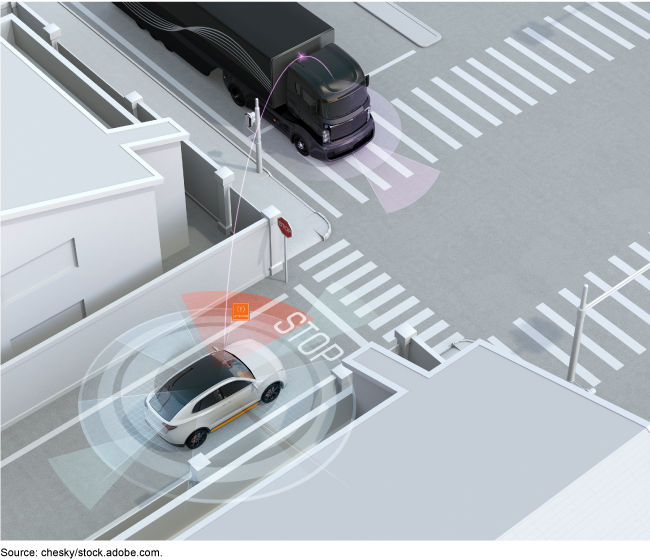Connected Vehicles: Additional DOT Information Could Help Stakeholders Manage Spectrum Availability Challenges and New Rules
Fast Facts
Connected vehicle technologies could reduce crashes by allowing vehicles, infrastructure, and road users' personal devices to communicate wirelessly. Exchanging messages via dedicated radio frequencies can help cars "see" around corners and avoid hazards.
In 2020, the Federal Communications Commission reduced the radio frequency spectrum dedicated to these technologies by 60%.
The Department of Transportation is developing a strategy to get these technologies onto the roads with less spectrum. We recommended sharing more information about that strategy to help transportation stakeholders plan their technology investments.

Highlights
What GAO Found
Since 1999, the U.S. Department of Transportation (DOT) has pursued efforts to advance the deployment of connected vehicle (CV) technologies, which enable data to be exchanged among vehicles, infrastructure and road users' personal devices. A driver could receive, for example, a warning about a vehicle that is braking hard on the road ahead but not visible to the driver (see figure below for examples of CV warning messages). According to DOT, these technologies could significantly reduce crashes and improve traffic efficiency. To create a CV environment requires several components, including vehicles and transportation infrastructure equipped with devices to exchange messages. A CV environment also requires radio spectrum (the medium for exchanging messages), and a shared communication protocol or “common language” so messages can be reliably and quickly exchanged. Two communication protocols are available, the original protocol used for CV technologies and a newer protocol. DOT has provided over $800 million in related federal research grants. As of September 2022, transportation agencies in 38 states held licenses to use CV technologies from the Federal Communications Commission (FCC), the agency responsible for regulating, allocating, and assigning non-federal spectrum. Some transportation agencies have deployed CV technologies on roadside infrastructure, but few automakers have produced vehicles equipped for exchanging safety messages.
Examples of Connected Vehicle Warning Messages

In 2020, FCC changed the communication protocol for and repurposed 60 percent of the spectrum previously allocated to CV technologies to be used for Wi Fi and other wireless users. DOT is taking steps to respond to these spectrum changes, including assessing whether CV technologies that use the new communications protocol can provide safety benefits under the new spectrum rules. DOT has shared some information about its strategy for facilitating the further deployment of CV technologies. However, most of the transportation stakeholders GAO interviewed (18 of 23) said that more information about DOT's strategy to facilitate the deployment of CV technologies could be helpful. By sharing more information with stakeholders, such as the estimated timeframes for key steps to advance CV technologies that use the new communication protocol and achieve nationwide deployment, DOT can help to reduce stakeholders' uncertainty and help them plan their own actions related to investing in CV technologies.
Why GAO Did This Study
DOT estimates that automobile crashes caused 42,915 fatalities in 2021, the highest number for any year since 2006. According to DOT, CV technologies that enable radio communication among vehicles and roadway infrastructure could significantly reduce crashes while also improving traffic efficiency. In 1999, FCC allocated spectrum in the 5.9 GHz spectrum band for CV technologies but then, in 2020, repurposed some spectrum to increase access for Wi Fi and other unlicensed wireless users. DOT and transportation stakeholders have voiced concerns that the reduced spectrum could prevent CV technologies from achieving their intended safety and other benefits.
GAO was asked to examine the status of CV technologies and relevant federal efforts. This report discusses (1) DOT's efforts to facilitate the deployment of connected vehicle technologies and (2) how DOT is addressing challenges to the further deployment of connected vehicle technologies. GAO reviewed documents, interviewed agency officials including from DOT and FCC, and interviewed a non-generalizable sample of 40 stakeholders. Our sample included 23 transportation stakeholders and seven wireless industry stakeholders.
Recommendations
GAO recommends that DOT share additional information about its strategy to support the future deployment of connected vehicle technologies under the new spectrum rules.
DOT agreed with this recommendation.
Recommendations for Executive Action
| Agency Affected | Recommendation | Status |
|---|---|---|
| Department of Transportation | The Secretary of Transportation should share additional information about the Department's strategy to support the future deployment of connected vehicle technologies under the new spectrum rules. This information could include, for example, how the spectrum changes could influence DOT's grant funds that state and local transportation agencies have used to pursue connected vehicle projects. (Recommendation 1) |
In September 2024, GAO confirmed that DOT shared information about its deployment strategy. Specifically, DOT: 1) conducted spectrum interference testing with its industry partners using the new communication protocol and made the test data publicly available, 2) held an industry summit to present the concept for its deployment plan and solicit input concerning the prioritization and timing of the plan's milestones, 3) released a draft of its deployment plan and requested public comments, and 4) issued a National V2X Deployment Plan (plan) that describes its vision for interoperable and cybersecure connected deployments nationwide. By sharing deployment information and issuing a national plan, DOT should be able to reduce stakeholders' uncertainty and help them plan their own actions related to investing in CV technologies.
|
